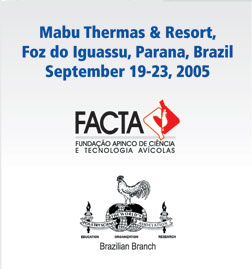MOLECULAR CHARACTERIZATION AND COMPARATIVE ANALYSIS
OF MITOCHONDRIAL GENOMES OF Eimeria SPP.
C.M. Romano1, P.M.A. Zanotto2, S. Fernandez1,
A.M.B.N. Madeira1; M. Pakandl2, M.W. Shirley3 &
A. Gruber1,*
1Faculty of Veterinary Medicine and
Zootechny, 2Institute of Biomedical Sciences, University
of São Paulo, Brazil; 2Institute of Parasitology,
Academy of Sciences of the Czech Republic, Czech Republic;
3Institute for Animal Health, Compton, United Kingdom
*argruber@usp.br
The mitochondrial
genome of Apicomplexa has been characterized in Plasmodium
spp. and Theileria spp. In the former genus, it corresponds
to a linear molecule composed by 15-150 tandemly repeated
copies of a 6 kb element, comprising three cytochrome
genes (cytb, coxI and coxIII) and some stretches of
rRNA genes. In order to characterize the mitochondrial
genomes of Eimeria spp., our group has determined
the complete mtDNA sequences of the seven Eimeria
species that infect the domestic fowl, plus two species
of domestic rabbit: E. coecicola and E. flavescens.
In addition, the mitochondrial genomes of five distinct
strains of E. tenella were also sequenced. All mtDNA
sequences showed a size of circa 6 kb and contained
the cytochrome genes reported for other apicomplexan
parasites. A multiple sequence alignment, using sequences
derived from the nine Eimeria species, revealed a
cross-similarity of around 90%. A comparison of the
mitochondrial genomes of Eimeria spp. and other apicomplexan
parasites showed a conservation of the gene order
and orientation among different species, but not across
distinct genera. These "shuffling" events
could be related to the replication mechanism of these
genomes, primarily based on recombination events and
rolling circle activity. Another interesting finding
was the high AT content, of circa 65%, with a highly
conserved codon usage, strongly biased towards the
use of A/T bases at the third position. Regarding
intra-specific variability, the five E. tenella strains
revealed a high conservation, with only two consecutive
thymines being deleted in strains MC (Brazilian) and
Wisconsin (North American), when compared to strains
H, TA and Wey (isolated in the UK). This high level
of conservation has also been observed in mtDNAs of
P. falciparum strains, and may reflect a very recent
common origin of the strains. A phylogenetic reconstruction
of the different Eimeria species, using both mitochondrial
nucleotide sequences and 18S rRNA, showed a good agreement
between these markers. Using cytochrome b sequences
in a phylogenetic analysis of Apicomplexa, the Coccidia,
Piroplasmida and Haemosporida classes were clearly
grouped into distinct clades, as should be expected
according to their taxonomy.
Financial support: FAPESP and CNPq
